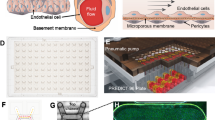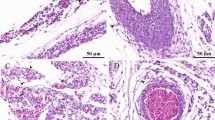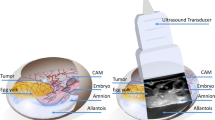Abstract
Here we present a method for the quantification of angiogenesis and antiangiogenesis in the chick embryo chorioallantoic membrane (CAM) based on the implantation of a gelatin sponge on the top of the growing CAM on day 8 of development. After implantation, the sponge is treated with a stimulator of blood vessel formation in the absence or presence of an angiogenesis inhibitor. On day 12, blood vessels that are growing into the sponge are counted at macroscopic and microscopic levels. The estimated timeline for carrying out this protocol is 10 d. The presence of a vascular network in the CAM requires a careful analysis to distinguish new capillaries from pre-existing ones. This limitation does not occur in the avascular cornea assay, which may also take advantage of different genetic backgrounds when carried out in transgenic or knockout mice. Nevertheless, the gelatin sponge–CAM assay is simple, inexpensive and suitable for large-scale screening.
*Note: In the version of the article initially published online, references 6 and 7 were incorrect. The correct references are: 6. Serbedzija, G.N., Flynn, E. & Willet, C.E. Zebrafish angiogenesis: a new model for drug screening. Angiogenesis 3, 519–528 (2000). 7. Ribatti, D., Vacca, A., Roncali, L. & Dammacco, F. The chick embryo chorioallantoic membrane as a model for in vivo research on angiogenesis. Int. J. Dev. Biol. 40, 1189–1897 (1996). The error has been corrected in all versions of the article.
This is a preview of subscription content, access via your institution
Access options
Subscribe to this journal
Receive 12 print issues and online access
$259.00 per year
only $21.58 per issue
Buy this article
- Purchase on Springer Link
- Instant access to full article PDF
Prices may be subject to local taxes which are calculated during checkout






Similar content being viewed by others
Change history
10 August 2006
In the version of the article initially published online, references 6 and 7 were incorrect. The correct references are:
References
Auerbach, R., Auerbach, W. & Polakowski, I. Assays for angiogenesis: a review. Pharmacol. Ther. 51, 1–11 (1991).
Ribatti, D. & Vacca, A. Models for studying angiogenesis in vivo. Int. J. Biol. Markers 14, 207–213 (1999).
Andrade, S.P., Fan, T.P.D. & Lewis, G.P. Quantitative in vivo studies on angiogenesis in a rat sponge model. Br. J. Exp. Pathol. 68, 755–766 (1987).
Fajardo, L.F., Kowalski, J., Kwan, H.H., Prionas, S.D. & Allison, A.C. The disc angiogenesis system. Lab. Invest. 58, 718–724 (1998).
Passaniti, A. et al. A simple, quantitative method for expressing angiogenesis and antiangiogenic agents using reconstituted basement membrane, heparin, and fibroblast growth factor. Lab. Invest. 67, 519–528 (1992).
Serbedzija, G.N., Flynn, E. & Willets, C.E. Zebrafish angiogenesis: a new model for drug screening. Angiogenesis. 3, 519–528 (2000).
Ribatti, D., Vacca, A., Roncali, L. & Dammacco, F. The chick embryo chorioallantoic membrane as a model for in vivo research on angiogenesis. Int. J. Dev. Biol. 40, 1189–1897 (1996).
Ribatti, D. The first evidence of the tumor-induced angiogenesis in vivo by using the chorioallantoic membrane assay dated 1913. Leukemia 18, 1350–1351 (2004).
Ausprunk, D.H., Knighton, D.R. & Folkman, J. Vascularization of normal and neoplastic tissues grafted to the chick chorioallantois. Am. J. Pathol. 79, 597–610 (1975).
Knighton, D., Ausprunk, D.H., Tapper, D. & Folkman, J. Avascular and vascular phases of tumor growth in the chick embryo. Br. J. Cancer 35, 347–356 (1977).
Ribatti, D. et al. Angiogenesis induced by B-cell non-Hodgkin's lymphomas. Lack of correlation with tumor malignancy and immunologic phenotype. Anticancer Res. 10, 401–406 (1990).
Wilting, J., Christ, B. & Bokeloh, M. A modified chorioallantoic membrane (CAM) assay for qualitative and quantitative study of growth factors. Anat. Embryol. (Berl.) 183, 259–271 (1991).
Ausprunk, D.H., Knighton, D.R. & Folkman, J. Differentiation of the vascular endothelium in the chick chorioallantois: a structural and autoradiographic study. Dev. Biol. 38, 237–247 (1974).
Leene, W., Duyzings, M.J.M. & Von Steeg, C. Lymphoid stem cell identification in the developing thymus and bursa of Fabricius of the chick. Z. Zellforsh. 136, 521–533 (1973).
Knighton, D.R., Fiegel, V.D. & Philipps, G.D. The assays for angiogenesis. Prog. Clin. Biol. Res. 365, 291–299 (1991).
Gimbrone, M.A.J., Cotran, R.S., Leapman, S.B. & Folkman, J. Tumor growth and neovascularization: an experimental model using the rabbit cornea. J. Natl. Cancer Inst. 52, 413–427 (1974).
Hasan, J. et al. Quantitative angiogenesis assays in vivo. A review. Angiogenesis 7, 1–16 (2004).
Chen, C. et al. A strategy to discover circulating angiogenesis inhibitors generated by human tumors. Cancer Res. 55, 4230–4233 (1995).
Jakob, W., Jentzsch, K.D., Manersberger, B. & Heider, G. The chick chorioallantoic membrane as bioassay for angiogenesis factors: reactions induced by carrier materials. Exp. Pathol. 15, 241–249 (1978).
Spanel-Burowski, K., Schnapper, U. & Heymer, B. The chick chorioallantoic membrane assay in the assessment of angiogenic factors. Biomed. Res. 9, 253–260 (1988).
Ribatti, D. et al. New model for the study of angiogenesis and antiangiogenesis in the chick embryo chorioallantoic membrane: the gelatin sponge/chorioallantoic membrane assay. J. Vasc. Res. 34, 455–463 (1997).
Ribatti, D. et al. Cell-mediated delivery of fibroblast growth factor-2 and vascular endothelial growth factor onto the chick chorioallantoic membrane: endothelial fenestration and angiogenesis. J. Vasc. Res. 38, 389–397 (2001).
Ribatti, D., Alessandri, G., Vacca, A., Iurlaro, M. & Ponzoni, M. Human neuroblastoma cells produce extracellular matrix-degrading enzymes, induce endothelial cell proliferation and are angiogenic in vivo. Int. J. Cancer 77, 449–454 (1998).
Vacca, A. et al. Human lymphoblastoid cells produce extracellular matrix-degrading enzymes and induce endothelial cell proliferation, migration, morphogenesis, and angiogenesis. Int. J. Clin. Lab. Res. 28, 55–68 (1998).
Vacca, A. et al. Bone marrow neovascularization, plasma cell angiogenic potential, and matrix metalloproteinase-2 secretion parallel progression of human multiple myeloma. Blood 93, 3064–3073 (1999).
Ribatti, D., Nico, B., Vacca, A., Roncali, L., Burri, P.H. & Djonov, V. Chorioallantoic membrane capillary bed: a useful target for studying angiogenesis and anti-angiogenesis in vivo. Anat. Rec. 264, 317–324 (2001).
Folkman, J. & Cotran, R. Relation of vascular proliferation to tumor growth. Int. Rev. Exp. Pathol. 16, 207–248 (1976).
Barnhill, R.L. & Ryan, T.J. Biochemical modulation of angiogenesis in the chorioallantoic membrane of the chick embryo. J. Invest. Dermatol. 81, 485–488 (1983).
Dusseau, J.W., Hutchins, P.M. & Malsaba, D.S. Stimulation of angiogenesis by adenosine on the chick chorioallantoic membrane. Circ. Res. 59, 163–170 (1986).
Conconi, M.T. et al. Ghrelin inhibits FGF-2 mediated angiogenesis in vitro and in vivo. Peptides 25, 2179–2185 (2004).
Acknowledgements
This work was supported by Associazione Italiana per la Ricerca sul Cancro (AIRC, National and Regional Funds), Milan; MIUR (Interuniversity Funds for Basic Research, FIRB 2001, Center of Excellence IDET, and PRIN 2005), Rome; Istituto Superiore di Sanità (Oncotechnological Project), Rome; Fondazione Italiana per la Lotta al Neuroblastoma, Genoa, Italy.
Author information
Authors and Affiliations
Corresponding author
Ethics declarations
Competing interests
The authors declare no competing financial interests.
Rights and permissions
About this article
Cite this article
Ribatti, D., Nico, B., Vacca, A. et al. The gelatin sponge–chorioallantoic membrane assay. Nat Protoc 1, 85–91 (2006). https://doi.org/10.1038/nprot.2006.13
Published:
Issue Date:
DOI: https://doi.org/10.1038/nprot.2006.13
This article is cited by
-
Chorioallantoic membrane assay revealed the role of TIPARP (2,3,7,8-tetrachlorodibenzo-p-dioxin-inducible poly (ADP-ribose) polymerase) in lung adenocarcinoma-induced angiogenesis
Cancer Cell International (2023)
-
In vivo antiangiogenic effect of nimbolide, trans-chalcone and piperine for use against glioblastoma
BMC Cancer (2023)
-
In vivo self-assembly and delivery of VEGFR2 siRNA-encapsulated small extracellular vesicles for lung metastatic osteosarcoma therapy
Cell Death & Disease (2023)
-
Formulation of nanoemulsions enriched with chalcone-based compounds: formulation process, physical stability, and antimicrobial effect
Polymer Bulletin (2023)
Comments
By submitting a comment you agree to abide by our Terms and Community Guidelines. If you find something abusive or that does not comply with our terms or guidelines please flag it as inappropriate.



